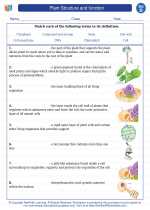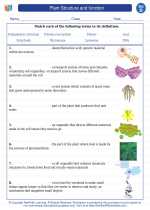Plant Structure and function -> cartilage
What is Cartilage?
Cartilage is a type of connective tissue found in the human body. It is a firm, flexible tissue that is not as hard as bone but is stiffer and less flexible than muscle.
Types of Cartilage
There are three main types of cartilage in the human body:
- Hyaline cartilage: found at the ends of bones, in the nose, and in the trachea and larynx.
- Elastic cartilage: found in the external ear and parts of the larynx.
- Fibrocartilage: found in the intervertebral discs and in some joints.
Functions of Cartilage
Cartilage serves several important functions in the body:
- It provides a smooth surface for joint movement.
- It acts as a shock absorber in the joints.
- It provides structure and support to the body, such as in the nose and ears.
Cartilage Growth and Repair
Unlike other types of connective tissue, cartilage does not have its own blood supply. As a result, it has a limited capacity for self-repair. Cartilage growth and repair are slower processes compared to other tissues in the body.
Study Guide
Here are some key points to remember about cartilage:
- What are the three main types of cartilage in the human body?
- What are the functions of cartilage in the body?
- How does cartilage differ from bone and muscle in terms of hardness and flexibility?
- Why does cartilage have a limited capacity for self-repair?
◂Science Worksheets and Study Guides Fourth Grade. Plant Structure and function
Study Guide Plant Structure and function
Plant Structure and function  Worksheet/Answer key
Worksheet/Answer key Plant Structure and function
Plant Structure and function  Worksheet/Answer key
Worksheet/Answer key Plant Structure and function
Plant Structure and function  Worksheet/Answer key
Worksheet/Answer key Plant Structure and function
Plant Structure and function  Vocabulary/Answer key
Vocabulary/Answer key Plant Structure and function
Plant Structure and function  Vocabulary/Answer key
Vocabulary/Answer key Plant Structure and function
Plant Structure and function  Vocabulary/Answer key
Vocabulary/Answer key Plant Structure and function
Plant Structure and function  Vocabulary/Answer key
Vocabulary/Answer key Plant Structure and function
Plant Structure and function 

 Worksheet/Answer key
Worksheet/Answer key
 Worksheet/Answer key
Worksheet/Answer key
 Worksheet/Answer key
Worksheet/Answer key
 Vocabulary/Answer key
Vocabulary/Answer key
 Vocabulary/Answer key
Vocabulary/Answer key
 Vocabulary/Answer key
Vocabulary/Answer key
 Vocabulary/Answer key
Vocabulary/Answer key

The resources above cover the following skills:
LIFE SCIENCE (NGSS)
From Molecules to Organisms: Structures and Processes
Students who demonstrate understanding can:
Construct an argument that plants and animals have internal and external structures that function to support survival, growth, behavior, and reproduction.